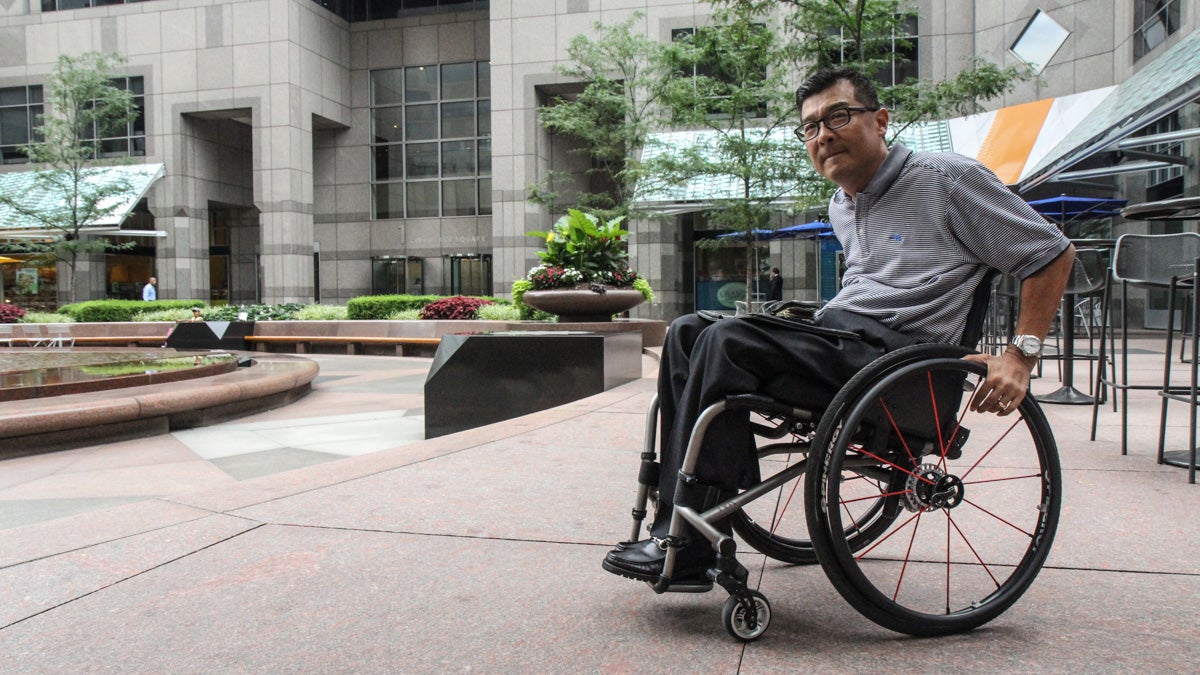The Americans with Disabilities Act turns 25, still faces daunting challenges
Listen
Attorney Won Shin. (Kimberly Paynter/for WHYY)
The ADA is regularly touted as a spectacularly successful piece of legislation, but the employment picture for the disabled is a frontier the law has yet to transform.
A sweeping piece of civil rights legislation celebrates its 25th anniversary this week. On July 26th, 1990, President George H. W. Bush signed the Americans With Disabilities Act into law, and promised a new beginning for millions of Americans.
“Every man, woman and child with a disability can now passed through once-closed doors into a bright new era of equality, independence and freedom.”
Getting around before barriers were removed
Philadelphia lawyer Won Shin remembers the time before the ADA became law, when there was little required legally to accommodate those with disabilities.
The summer after Won Shin completed his first year of college he had an accident at the beach, diving headfirst into a sandbar and becoming paralyzed from the chest down.
About a year later, after undergoing hospitalization and rehabilitation, Shin fulfilled his goal of returning to Texas Christian University to continue college. It was August of 1987.
“It was a new frontier for me, trying to navigate campus,” Shin said. “I think the school was also at the same time very accommodating in what they could provide for me to get around.”
Right around 1989, Won was getting ready to apply to law school and signed up to take the LSAT.
“When I got there that morning, there was no desk, there was no table,” he recalled. “And this is the LSATs, I had to take them then because the timing of that test depended on when I was going to apply to law school, so there was no postponing it. So we improvised–we got two chairs, just regular desk chairs. They found a piece of plywood and they put it on top of the two chairs and made a desk. I mean, it was an interesting way to take the LSATs, the plywood was grainy and had chips in it and it made filling in circles a bit difficult.”
Back then, he says, there was no point in getting upset. The ADA was still being drafted.
“But I can tell you now, 28 years post my injury, 25 years post signing of the ADA, that if I see a business or a situation where the accessibility is not there or it’s a clear violation of the ADA or people just don’t care, I do get upset.”
Helping to implement the ADA
The landmark piece of legislation granted civil rights to be people with physical and non-physical disabilities, probably the largest minority group in the country. And four years after the ADA was signed into law, Shin moved back to Philadelphia and became the executive director of the Mayor’s Commission on People with Disabilities. Getting the city ADA-compliant was no easy task, he says.
“It came with a price…that many business and state governments and employers were questioning on how to fund. How were businesses going to make their buildings, their places of business accessible? How much would it cost them? How much would the state governments need to make their public transit systems accessible? How much would employers need to provide reasonable accommodation?”
Transportation, for example, was and still is a challenge. Back then, in 1994, Shin remembers hearing horror stories of bus drivers just passing wheelchair users by. Today, most buses are equipped to handle wheelchairs but wheelchair friendly taxi cabs, for example, are hard to come by.
But, what remains ahead, Shin says, is the need to bridge the gap between employers and the needs of people with disabilities to find work. “I think once we can improve in that area, then we’ve really accomplished what the ADA was intended to accomplish,” he added.
Employment remains a major challenge
“The unemployment rate of people with disabilities is twice as high as that of those without disabilities,” agreed Fred Maahs, Vice President of the Comcast Foundation, and a recent chairman of the American Association of People with Disabilities (AAPD).
He explained that about 65% of people with disabilities are employable, but they continue to have trouble finding jobs. “I think there are many ways to overcome those disparities,” said Maahs, who uses a wheelchair to get around. Like Shin, Maahs also injured his spinal cord diving into a sandbar. “The ADA has made great advancements to remove physical barriers, but there are still attitudinal barriers.”
Maahs believes misconceptions are to blame for the employment gap. Employers think workplace accommodations are going to cost thousands of dollars, when in fact they typically cost $500 or less,” he said. He added that many employers are falsely believe that people with disabilities will take more time off from work due to illness, or will leave their job quickly.
“Instead, what you’ll find is that people with disabilities want to stay… The company has shown an interest in them, and the employee has that loyalty to the company.”
Maahs says a lot of organizations are spreading the word about employing people with disabilities, but he thinks ultimately, it is up to individuals to bring about change.
“Frankly, we as individuals have to have a stronger voice and speak a little louder. We are here, we want to work…let us help educate you how to go about it!”
WHYY is your source for fact-based, in-depth journalism and information. As a nonprofit organization, we rely on financial support from readers like you. Please give today.



